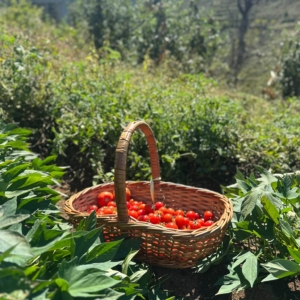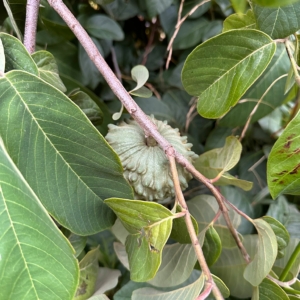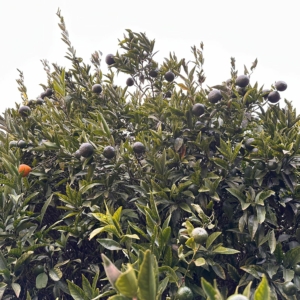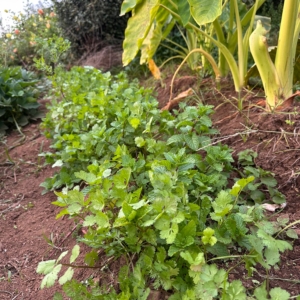The Story of Our Menu
Madeiran cuisine is a living reflection of the archipelago’s history. Influenced by Portuguese traditions and the island’s unique products, such as fresh Atlantic fish, tropical fruits, and the famous Madeira wine, local cuisine combines simplicity and authentic flavor. Since the time of the first settlers in the 15th century, recipes have been passed down from generation to generation, keeping the connection between the sea, the mountains, and the table alive. Each dish tells a story of hospitality and celebration—a true journey through the flavors of Madeira.
Origin of products
In our kitchen, we deeply value the origin of products and we always endeavor to use regional ingredients from our Island, thus promoting sustainability and local gastronomic identity. We believe that each product carries the history and flavor of our region, and that the best way to honor Madeira’s agricultural culture is to use it as the basis of our cuisine.
Whenever possible, we work with fresh and regional products such as, for example, the sweet potato, white potato, red potato and banana, grown in the fertile soils of the island; the bay leaf and lemon, harvested from local farms; the chicken and eggs from regional producers; the black scabbardfish, symbol of the Madeiran sea link to our cuisine, the curd cheese of the municipality “Santo da Serra”, the yam, corn flour from the municipality of “Santana”, Madeiran couscous, also reflect agricultural traditions and recipes that are part of everyday life in Madeira.
In addition to products, we prioritize partnerships and purchasing products with local companies, like the Insular, a Sodiprave and Friic Ice Cream, reinforcing our commitment to the regional economy. Thus, our menu is not just a collection of dishes—it’s a celebration of Madeira, its producers, and the expertise that defines its gastronomy.
When we are unable to purchase or use regional products, we prioritize national production and the use of national brands such as Cigala rice, among others.
Our goals with our cuisine and our restaurant
Our restaurant embraces regional production as the foundation of the quality we serve at our tables. We value local, fresh, and seasonal ingredients, and we want to go beyond, and try to produce ourselves in the farm lands owned by the owners of our restaurant, so we can bring the food from farm to table.
Thus, we build a concept of long-term sustainability—rooted in the land, committed to the community, and reflected in every dish that reaches the customer.
Starters
Bolo do Caco
Bolo do Caco it’s a traditional bread from Madeira Island, created out of the need to bake bread without an oven. Originally prepared on a hot basalt stone, it combines wheat flour and sweet potato, giving it a soft texture and a slightly sweet flavor. Inspired by Arab influences and the scarcity of grains, it has become a symbol of Madeiran cuisine.
Bruschetta
Inspired by Madeira’s traditional carne de vinho d’alhos (garlic pork stew)—a dish with centuries of history—this bruschetta combines the authenticity of regional flavors with a modern twist. Marinated in wine, garlic, and spices, this type of meat preparation has its origins in the meat preservation practices used by Madeira’s first settlers in the 15th century. Traditionally prepared at Christmas, it has become a symbol of the island’s popular cuisine. In this contemporary version, the meat is served on toasted bread with orange segments and confit garlic, creating a fusion of Madeiran tradition and the Mediterranean simplicity of bruschetta.
Sautéed Shrimp
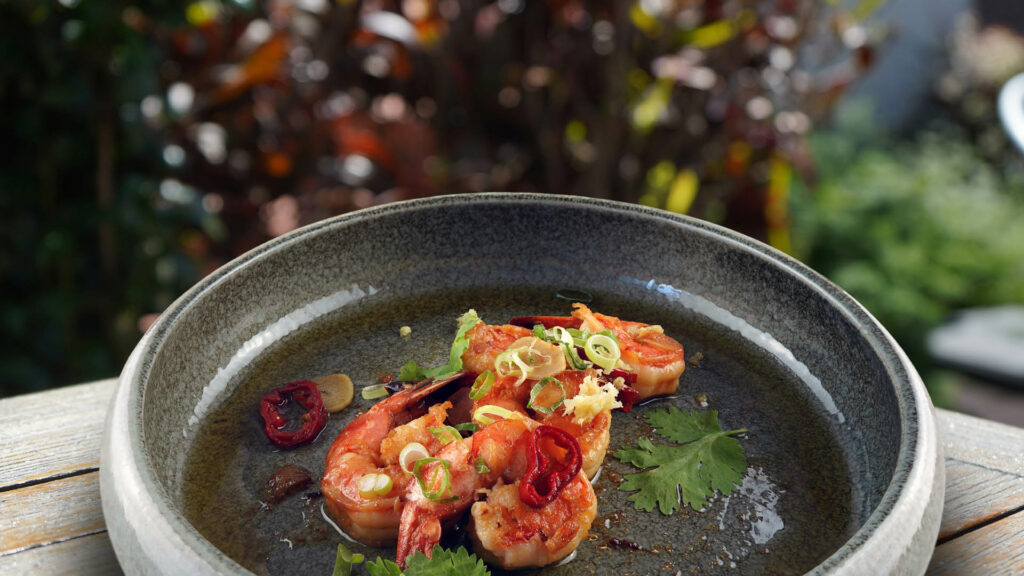
The sautéed shrimp is a popular dish in the Madeiran restaurants. We use a Madeiran brandy called Brandy 291 Madeira to enhance the flavor of our shrimp, enhancing the importance of local products used in our cuisine.
Cured tuna salad

Tuna plays an important role in Madeira’s gastronomic history, reflecting the island’s strong connection with the sea and artisanal fishing. For centuries, tuna has been caught in Atlantic waters and prepared in various ways—fresh, pickled, or cured—ensuring its preservation and enhancing the fish’s intense flavor. Salt and sugar curing is a modern technique inspired by traditional preservation methods, now reinterpreted with a contemporary twist. Beetroot, by adding color and natural sweetness, creates an elegant contrast to the tuna.
Accompanied by regional buttery fondant potatoes, tomate cherry and regional red onion pickle, the salad balances softness, acidity and texture, reflecting influences from modern signature cuisine.
Butternut Squash Carpaccio

Pumpkins have always been a vegetable used in Madeiran families for centuries, especially in soups. We’ve reinvented the use of pumpkin, serving it in carpaccio—an excellent alternative for
vegetarians and others alike! Santo da Serra’s requeijão, handcrafted from fresh milk from local producers, represents local expertise and care for the land’s produce. By combining these two elements, our butternut squash carpaccio with requeijão and pesto sauce, prepared by our kitchen, reinterprets traditional flavors in a light and contemporary dish.
Crispy swordfish Bites

Black scabbardfish is a symbol of Madeiran cuisine, caught in the depths of the Atlantic and prized for its delicate flavor and tender texture. This fish is one of the island’s most iconic fish, found both on family tables and in haute cuisine. Crispy scabbardfish bites are a modern interpretation of this traditional product, combining the authentic flavor of the sea with a light, golden texture. They represent the fusion of Madeira’s maritime heritage and the creativity of contemporary cuisine.
Soups
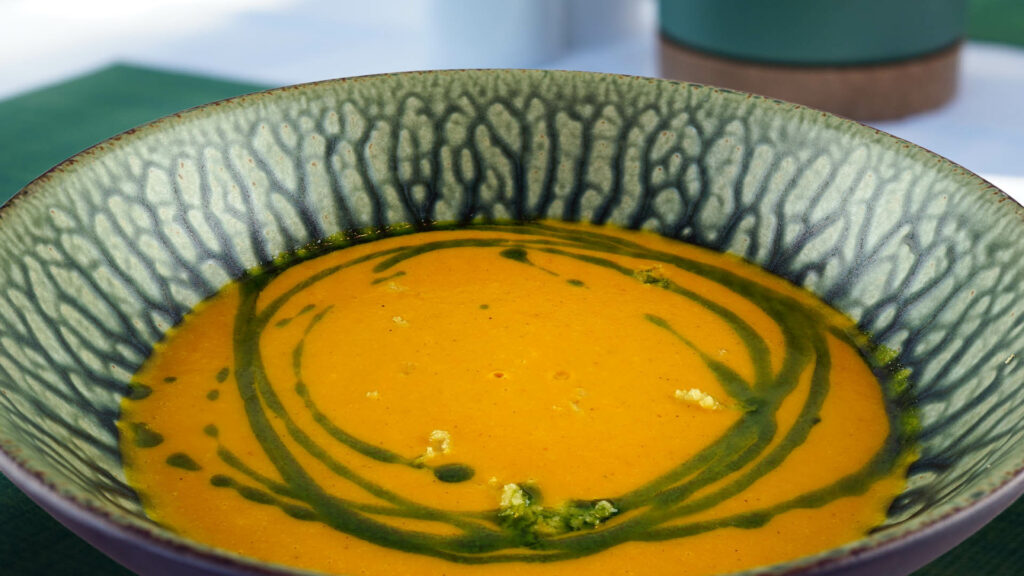
Soups and creams have always been a part of Madeiran Cuisine, reflecting the islanders’ deep connection to agriculture and the produce of the land. Traditionally prepared with vegetables harvested from family gardens—such as carrots, pumpkin, cabbage, and potatoes—these simple dishes provide sustenance and comfort in everyday life.
Main Dishes
Espetada
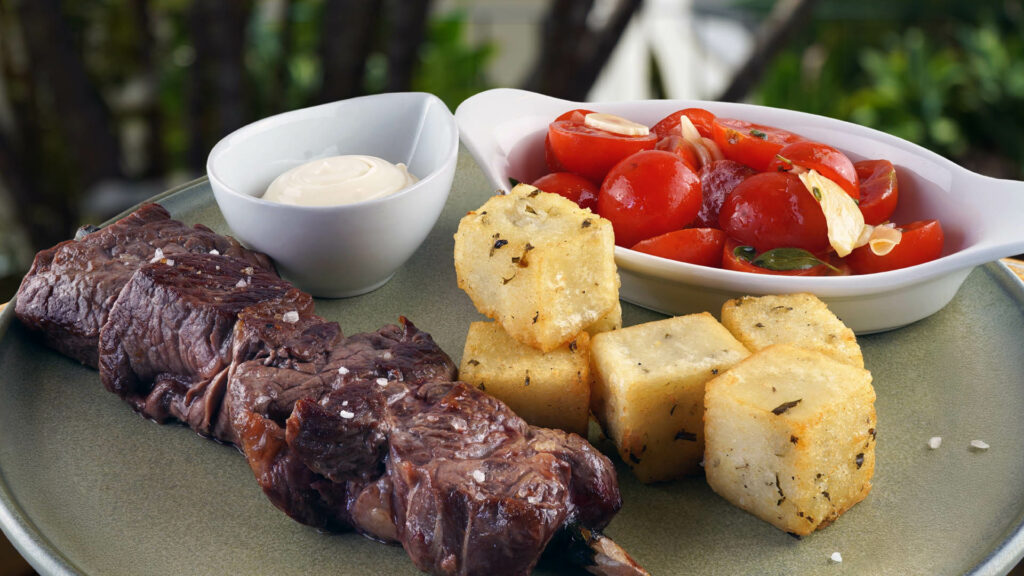
Madeiran Espetada is one of the island’s most traditional dishes, born from ancient rural festivals where meat was roasted on bay skewers over hot coals. Originally made with local beef, salt, and garlic, it became a symbol of conviviality and celebration. In this modern version, the choice of Angus chuck enhances the texture and flavor of the meat, keeping the essence of tradition alive. The side dish is fried corn, another icon of Madeiran cuisine, made with cornmeal from the island’s regional brand and mixed with 30% regional cornmeal from Santana (ground in the country’s only water mill) and kale from the Ponta do Pargo, completing the dish with authenticity. We also add smoked mayonnaise with orange blossom aroma; all these flavors represent the meeting of the memory of Madeiran festivals with the sophistication of contemporary cuisine.
Grilled mackerel
Mackerel is a fish abundant in the Atlantic waters surrounding Madeira. Considered a humble fish, it gained notoriety for its freshness and distinctive flavor, becoming a symbol of Madeiran seafood cuisine. Traditionally grilled, simple, and seasoned with salt and lemon, it embodies the
authenticity of local flavors. In this contemporary version, it’s served with typical Madeiran couscous mixed with vegetables.
Roast chicken
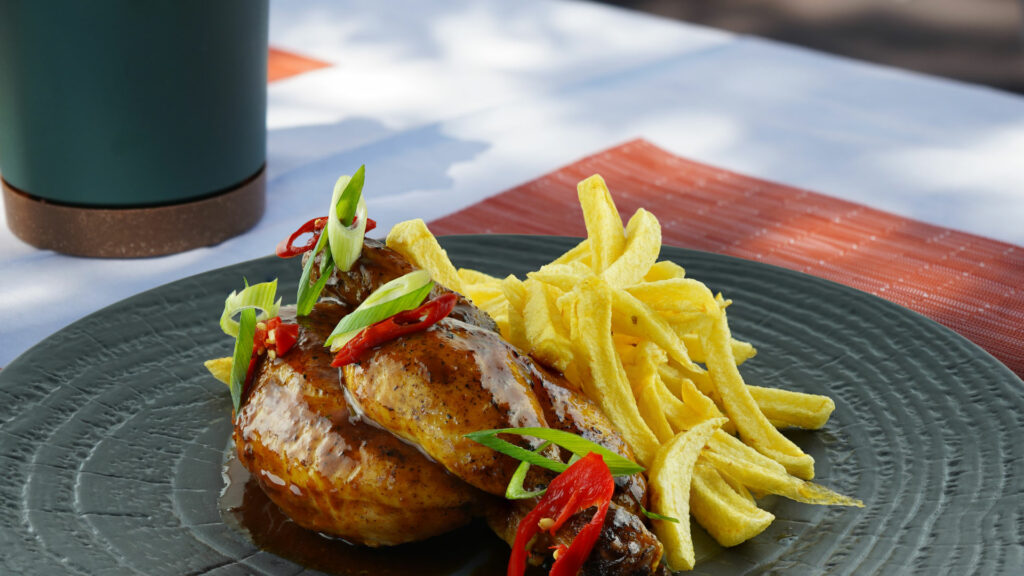
Roast chicken is a classic on Madeiran tables, prepared for decades in backyards, restaurants, and local festivals, always enhanced by simple seasonings and authentic flavors. We use chicken from small, local producers, served with homemade, regional fries, reinforcing the island’s connection to agriculture and fresh, local produce. The homemade sauce, made in our kitchen without additives or preservatives, adds a special touch, creating a combination of flavors that pays homage to Madeira’s popular tradition and the creativity of the island’s modern cuisine.
Braised tuna

Tuna is a prized fish in Madeiran cuisine. Simple preparations like grilling or braising highlight the fish’s natural flavor. Yam purée, traditionally grown on Madeira’s fertile soils, adds texture and a gentle sweetness, reflecting the island’s culinary connection to agriculture. Together, tuna and yam represent the harmony between sea and land, demonstrating how Madeiran cuisine elegantly combines tradition and innovation. Finally, this dish is topped with the famous “vilão” sauce, made with garlic, onion, butter, Madeira wine, and aromatic herbs. This sauce was born from the need to enhance the flavors of fresh fish.
Wrasse
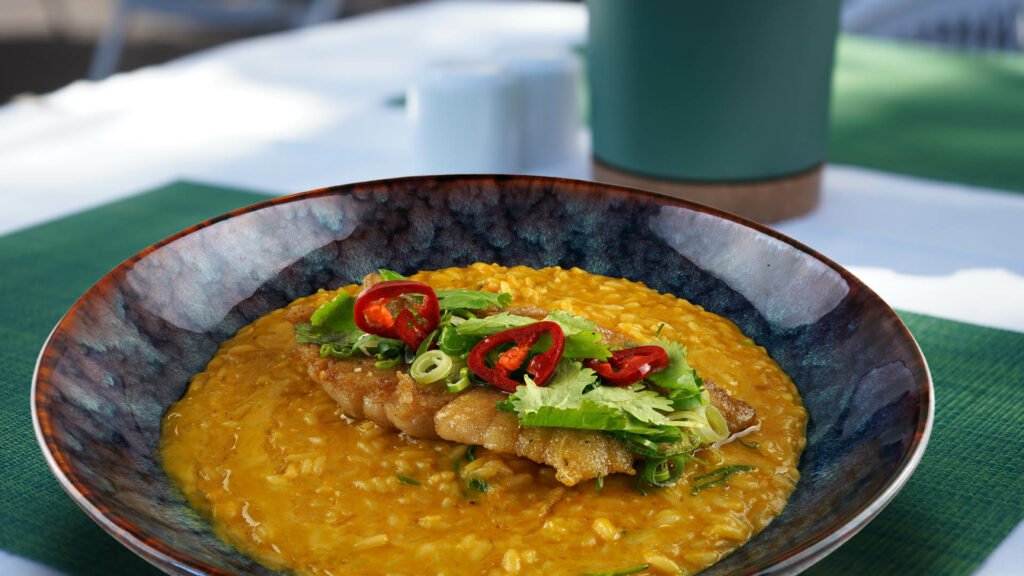
The wrasse, a fish typical of Atlantic waters, has always been appreciated at local tables for its firm texture and delicate flavor. Traditionally prepared simply, it has gained prominence in modern cuisine when paired with seafood.
Creamy shrimp rice, made from a delicious shrimp broth, reusing the parts of the shrimp that are not used, complements the wrasse excellently, creating a dish that pays homage to Madeira’s fishing tradition and the archipelago’s maritime wealth.
Rack of lamb
Lamb has always played a central role in Madeira’s rural cuisine, consumed at festivals and celebrations, especially at Easter and family gatherings. Chestnuts, traditionally used in sweets and side dishes, reflect their presence in the island’s forests, while sweet potatoes, grown on the fertile terraces, were a nutritious and affordable staple for families. Combining rack of lamb with a chestnut and aromatic herb crust and mashed sweet potatoes, this dish is a synthesis of Madeiran tradition and contemporary gastronomy, showcasing local produce with refined techniques and authentic flavor.
Desserts
Creme Brulee

Although crème brûlée is a dessert of French origin, our cuisine has adapted this classic technique using tropical fruits grown on the island, such as passion fruit, which has become an iconic ingredient of the region. The combination of the delicate cream with the acidity and freshness of passion fruit reflects Madeira’s agricultural wealth and the creativity of the new Madeiran cuisine, which values local products with innovation and flavor.
Banana Split

The banana is one of Madeira’s most iconic fruits, cultivated on the island’s fertile slopes for centuries and enjoyed both raw and in desserts. The classic banana split, of American origin, has been reinterpreted with local produce: Madeiran bananas, known for their unique sweetness and aroma, are accompanied by locally produced vanilla, chocolate, and passion fruit ice creams. This dessert exemplifies how Madeiran cuisine combines tradition and innovation, highlighting regional flavors and creating modern and authentic dining experiences.
Cheesecake

Santo da Serra’s requeijão is an iconic artisanal product from Madeira, made from fresh milk from small local producers and enjoyed for generations for its delicate flavor and creamy texture. Incorporating it into a cheesecake represents a fusion of local tradition and contemporary pastry techniques, showcasing excellent regional ingredients.
Caramelized pineapple
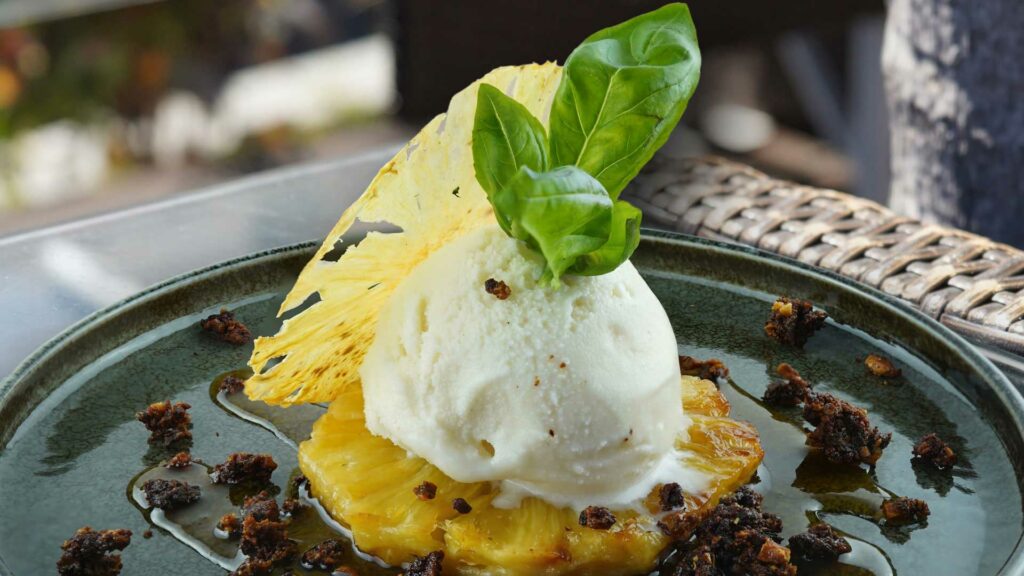
Our caramelized pineapple is drizzled with regional banana caramel and served with regional lemon and basil sorbet. This dessert combines contemporary confectionery techniques with local ingredients, highlighting the freshness and authenticity of Madeiran produce.
Dark chocolate fondant
Chocolate, appreciated worldwide, takes on a local dimension in Madeira when paired with Madeira wine, a historical and international symbol of the island, produced since the 15th century. Surinam cherry, a regional tropical fruit, adds freshness and authenticity to the dish. This dessert is an example of how Madeiran cuisine integrates local products with classic international techniques, offering intense and harmonious flavors that celebrate the island’s tradition and creativity.


